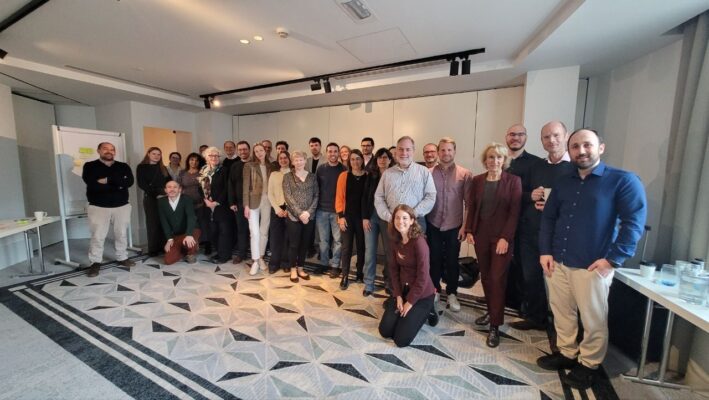Led by the project and coordination team, the BEAMER project assembly in Antwerp on March 12th and 13th proved to be a productive event. The teams spearheaded discussions on the mission statement and vision of BEAMER, setting the tone for the collaborative efforts ahead.

Throughout the assembly, updates from various work packages were provided, including insightful contributions from all work packages.
Despite the rainy skies outside, and inside the assembly venue, team members were fully engaged in discussions and strategic planning sessions. Jess Vogt from Empirica led an exploration of user scenarios and functionalities within the BEAMER model, while Merel Griepink facilitated discussions on needs elicitation and support development at PredictBy.
The meeting, serving as the project’s annual General Assembly, provided a platform for partners to engage in discussions on refining vision statements, strategizing communication efforts, and ensuring sustainability.
Stay tuned for further updates on the BEAMER project’s progress as we continue our journey towards improving adherence to treatment and driving positive change in healthcare.
Don’t forget to follow us on Twitter (X) and LinkedIn for continuous updates!
Feel free to share your thoughts by contacting us




Supported by a grant from IMI, the project has received funding from the Innovative Medicines Initiative 2 Joint Undertaking under grant agreement No 101034369. This joint undertaking receives support from the European Union’s Horizon 2020 research and innovation programme, the European Federation of Pharmaceutical Industries and Associations [EFPIA] and Link2Trials. The total budget is 11.9 M€ for a project duration of 60 months.
Disclaimer:
Information on this website reflects project owner’s views and neither IMI nor the European Union, EFPIA, or any Associated Partners are responsible for any use that may be made of the information contained therein.
The primary aim of the end user personas is to support the creation of materials to support the implementation of the BEAMER model framework and to help define requirements for the elements of the BEAMER model framework. Hence, healthcare professionals (HCPs) represent the primary envisaged end user group of the BEAMER model framework and the associated Adherence Intelligence Visualisation Platform (AIVP)
It is one learning from the joint design process that the job titles of healthcare professional team members do not necessarily predict the roles they would play within the change management process for implementing BEAMER and installing it as a standard model within healthcare. Additionally, the role and responsibilities of certain job titles, for example nurse, varies across different healthcare systems and would affect how they interact with the BEAMER model outputs and the access they would be permitted and so it would not be helpful to include these job titles: The four personas represent role-independent archetypes within the group of HCPs. They encompass a Managerial HCP Persona, an Implementer HCP Persona, a Support HCP Persona, and a Established HCP Persona.
These healthcare professional personas may be further tailored to specific healthcare settings depending on the needs of the individual pilot sites. Thus, adapted or spin-off versions of these original personas may be considered. The persona displays include a summarising statement, goals, challenges, experience, and needs to enhance the accessibility and usability of the model while minimising user burden.
Patient organisations are considered potential users of the model outputs. Consequently, personas were designed for these groups to assure that the implementation materials may also support their needs in the longer term, thus fostering sustainability of the project outputs.
The identified focus areas within this persona are goals, needs, skills and tools, along with potential challenges anticipated during the implementation process. The persona emphasises awareness-raising, capacity building, education, peer support provision, and the promotion of research and development in therapeutic care.
The patient organisation persona serves as a theoretical framework representing how patient organisations could benefit from and include the BEAMER model framework in their therapy and care related as well as their organisational work. This persona comprises the needs, goals, challenges and necessary tools, facilitating preparation and implementation of the model and optimising the user experience of patient organisations as end users of the BEAMER model framework. It can be used as a guide to identify potential obstacles and understand the prerequisites for a patient organisation to successfully adopt and integrate the BEAMER model framework.
“In implementing the BEAMER model, we want to be able to respond to the different needs of our patients to ensure their adherence, build a supportive community and improve outcomes.”